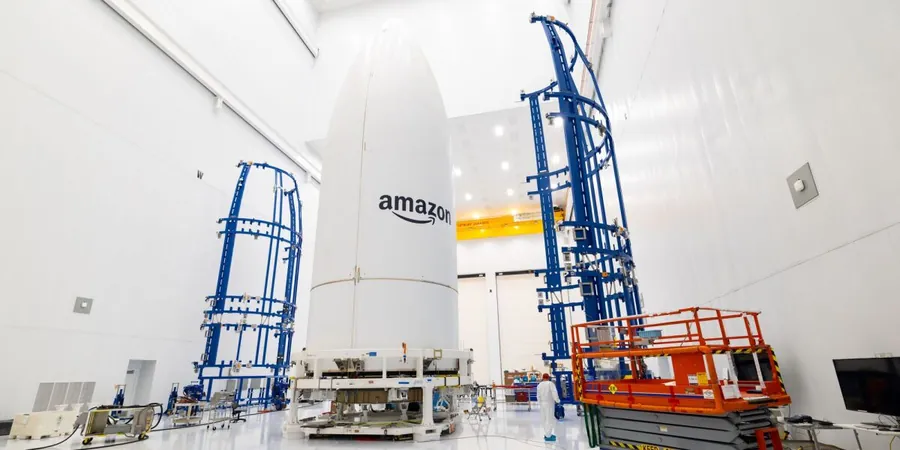
Project Kuiper Set to Launch First Batch of Satellites: What You Need to Know!
2025-04-02
Author: Kai
Introduction
Excitement is building as Project Kuiper prepares for its debut full-scale satellite launch, a crucial step in its mission to deliver high-speed internet connectivity to underserved areas globally. The mission, known as “KA-01” (Kuiper Atlas 1), is scheduled for liftoff on a United Launch Alliance (ULA) Atlas V rocket from Cape Canaveral Space Force Station in Florida at 12 p.m. EDT on April 9, 2024. This ambitious mission will see the deployment of 27 satellites at an altitude of approximately 280 miles (450 kilometers) above Earth.
Mission Goals and Objectives
Project Kuiper aims to provide low-latency internet access to virtually every corner of the globe, with expectations to start service delivery later this year. The satellite constellation is designed to include over 3,200 advanced satellites operating in low Earth orbit, and more than 80 launches have been secured to deploy this initial network, incrementally enhancing global connectivity.
Leadership Insight
Rajeev Badyal, the vice president at Project Kuiper, expressed enthusiasm, stating, “We’ve built some of the most advanced communications satellites ever created. Every launch brings us closer to expanding our coverage and capacity.” The KA-01 mission will not only test the final satellite design but is also set to deploy multiple satellites for the first time, offering invaluable data to inform future missions.
Technological Innovations
These satellites represent a significant technological leap from earlier prototypes tested in October 2023. With upgrades across various systems—including phased array antennas, processors, and propulsion systems—these new satellites also feature a unique dielectric mirror film to minimize their visibility from the ground, addressing concerns from the astronomical community.
Launch Details and Specifications
Uniquely, the KA-01 payload will be the heaviest ever launched by ULA’s Atlas V rocket, necessitating its most powerful configuration that includes five solid rocket boosters and a significantly large payload fairing that measures 77 feet (23.5 meters) in height and 16.4 feet (5 meters) in width.
Post-Launch Operations
As Project Kuiper embarks on this mission, ULA will manage the launch from its Advanced Spaceflight Operations Center, while after separation, the Kuiper team will handle constellation management from their mission operations center in Redmond, Washington. The priority for this mission is to ensure that all satellites are safely deployed and able to communicate with ground stations.
Orbit and Speed
Following the launch and initial deployment phase, the satellites will utilize electric propulsion systems to move into their operational orbits of 392 miles (630 km). Traveling at speeds exceeding 17,000 miles per hour (27,359 km/h), these satellites will complete an orbit around the planet approximately every 90 minutes.
Future Prospects
Looking ahead, Project Kuiper has ambitious plans for the future. After KA-01, the organization aims to ramp up production, processing, and deployment rates, preparing for the upcoming KA-02 mission, which will also utilize a ULA Atlas V rocket.
Join the Mission
In a twist of excitement, if you’re eager to be part of this revolutionary project and foster global internet access, Project Kuiper is on the lookout for talent to join its mission.
Conclusion
Stay tuned as we follow this significant launch that promises to change the face of internet connectivity worldwide!






 Brasil (PT)
Brasil (PT)
 Canada (EN)
Canada (EN)
 Chile (ES)
Chile (ES)
 Česko (CS)
Česko (CS)
 대한민국 (KO)
대한민국 (KO)
 España (ES)
España (ES)
 France (FR)
France (FR)
 Hong Kong (EN)
Hong Kong (EN)
 Italia (IT)
Italia (IT)
 日本 (JA)
日本 (JA)
 Magyarország (HU)
Magyarország (HU)
 Norge (NO)
Norge (NO)
 Polska (PL)
Polska (PL)
 Schweiz (DE)
Schweiz (DE)
 Singapore (EN)
Singapore (EN)
 Sverige (SV)
Sverige (SV)
 Suomi (FI)
Suomi (FI)
 Türkiye (TR)
Türkiye (TR)
 الإمارات العربية المتحدة (AR)
الإمارات العربية المتحدة (AR)